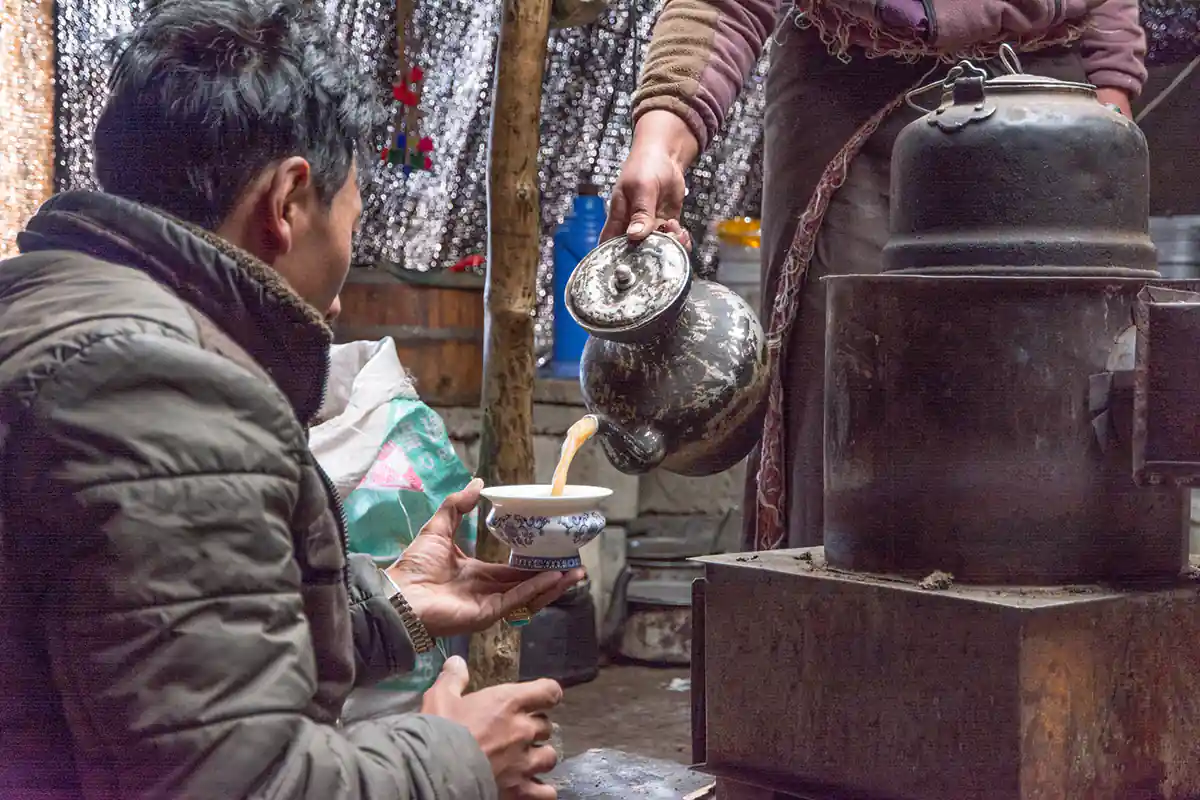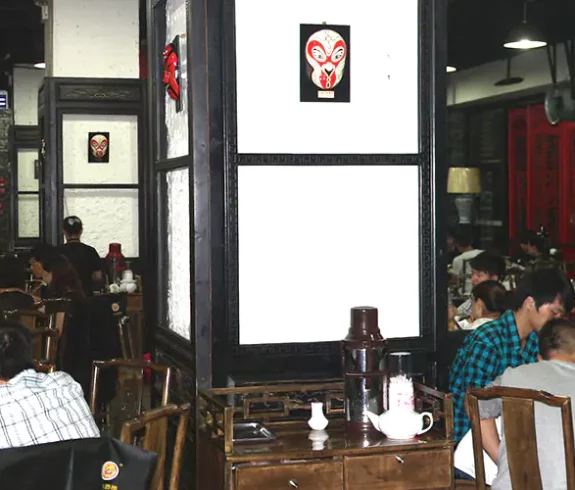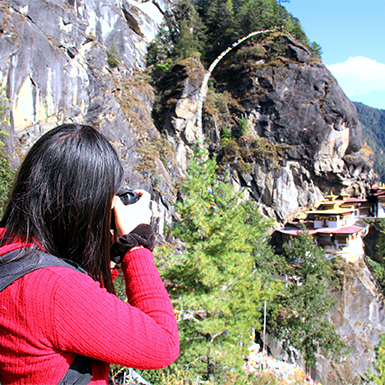Tibetan cuisine, nestled amidst the majestic Himalayas, offers a unique flavor explosion. This unique culinary heritage, shaped by the region’s unforgiving climate and influences from neighboring cultures, is a delightful marriage of bold flavors and essential ingredients.
Ingredients Born of High Altitude
Tibet’s frigid temperatures and high altitude define its cuisine. Fresh produce is scarce, leading to a strong emphasis on meats like yak, goat, and mutton—animals well-suited to the cold. Barley, the region’s most important crop that thrives in the short growing season, takes center stage. Transformed into tsampa, a roasted barley flour, it forms the base of many Tibetan dishes.
Culinary Crossroads of the Himalayas
Despite its geographical isolation, Tibetan food incorporates culinary traditions from neighboring regions. Some dishes feature hints of Indian spices and Nepalese techniques. This unique blend of influences creates a fascinating tapestry of familiar and exotic flavors.
A Culinary Adventure Awaits
Prepare for a delicious exploration of Tibetan food! We’ll delve into iconic Tibetan dishes like tsampa, explore flavorful vegetarian options, and introduce you to the region’s unique beverages.
Key Ingredients in Tibetan Cuisine
It adapted to the unforgiving conditions of the Himalayas and thrived on a unique set of ingredients. Let’s explore the staples that define this flavorful cuisine and understand how the region’s high altitude shapes Tibetan dietary habits.
The Mighty Barley: A Staple for Survival
Barley reigns supreme in Tibetan dishes. This hearty grain thrives in the short growing season at high altitudes, making it a dependable source of sustenance. Roasted and ground into a flour called tsampa, barley forms the base of many Tibetan dishes. Tsampa is eaten mixed with butter tea, cooked into porridge, or even rolled into dough for dumplings. Its versatility and nutritional value make it a cornerstone of the Tibetan diet.

Meat for the Mountains: Yak and Beyond
Fresh produce is a rarity in Tibet. As a result, meats that can withstand the cold climate play a vital role in Tibetan cuisine. Yak meat, rich in protein and fat, is a staple. Mutton and goats are also commonly consumed. These meats are often preserved by drying or cured, ensuring a year-round supply.
A Culture of Dairy: Butter and Cheese
Dairy products are another essential component of Tibetan food. Animals like yaks and cows, well-adapted to high altitudes, provide milk for butter and cheese production. With its high-fat content, Yak butter is a valuable energy source in cold climates. They churn it into butter tea, a popular warm and nourishing beverage. Tibetan cheese, often made from yak or goat milk, can be enjoyed or added to savory dishes.
Adapting to the Altitude: A High-Calorie Diet
The harsh climate of Tibet demands a high-calorie diet to maintain body heat and energy levels. The rich fat content in yak meat, butter, and cheese fuels people living at high altitudes. Additionally, barley’s easily digestible carbohydrates offer a sustained energy source. This unique combination of ingredients allows the Tibetan people to thrive in their extraordinary environment.
Must-Try Tibetan Dishes
Tibetan cuisine is a hidden gem nestled high in the Himalayas. It boasts unique flavors and hearty dishes. Let’s explore some of the must-try recipes that characterize this intriguing cooking tradition.
1. Tsampa (Roasted Barley Flour): The Foundation of Tibetan Food
Tsampa, the cornerstone of Tibetan cuisine, is a toasted barley flour from the region’s most important crop. Barley thrives in the short growing season at high altitudes. The roasting process intensifies the nutty flavor of the barley. Traditionally, people mix tsampa with yak butter tea to create a dough-like consistency. They also cook it into porridge or roll it into dumplings. Tibetan dishes showcase the versatility of tsampa in various dishes.
2. Momos (Tibetan Dumplings): A Delicious Bite
Momos, delectable Tibetan dumplings, come in various shapes and fillings. They typically contain meat such as yak, mutton, or pork, along with vegetables like cabbage, potatoes, and onions. Vegetarians can enjoy options filled with cheese, mushrooms, or lentils. People enjoy momos with dipping sauces ranging from spicy chili chutney to savory soy sauce blends. Regional variations add unique twists, incorporating local vegetables or spices.

3. Thukpa (Noodle Soup): A Comforting Broth
Thukpa, a comforting noodle soup, is a staple in Tibetan cuisine. It features hand-pulled noodles from wheat or barley flour simmered in a flavorful broth. The broth can be simple or include vegetables, meat (yak or mutton), and spices. Popular variations include Thenthuk, a noodle soup with a rich tomato base, and Gyathuk, a spicy soup with vegetables and yak meat.
4. Butter Tea (Po Cha): A Warming Beverage
Butter tea (Po Cha) is a cultural cornerstone and a must-try for visitors to Tibet. They brew this unique beverage with black tea, yak butter, and salt. They churn butter tea vigorously to create a frothy consistency. This rich beverage, high in calories and fat, is ideal for the high-altitude climate. While the taste might initially be unfamiliar, it’s a warming and nourishing drink deeply integrated into Tibetan hospitality.

5. Yak Meat Dishes: Exploring the Flavor of the Himalayas
Due to its resilience in the cold, yak meat, a staple protein source in Tibet, features various delicious dishes. Shapta, a popular street food, features yak skewers grilled over charcoal. Yak meat curries, stews, and stir-fries are also common. The meat has a unique flavor profile, slightly gamier than beef but with a richer taste. Stewing and slow-cooking are two culinary techniques that guarantee juicy, delicious meat.
Bonus Tip: It’s better to eat at a restaurant than at a hotel. Hotels close earlier, around 8 PM, have limited menu options, and are generally more expensive than restaurants.
Exploring Regional Variations
Like the majestic Himalayas, Tibetan cuisine offers a diverse landscape of flavors. While tsampa and yak meat reign supreme, regional variations add a unique twist to familiar dishes. Let’s explore how Tibetan food adapts across the region.
From Lhasa to the Local: A Culinary Journey
Lhasa, the capital city, boasts a wider variety of ingredients due to better access to trade routes. Here, you’ll find momos with more intricate fillings and curries featuring influences from neighboring countries. However, venturing into rural areas offers a more traditional experience. Dishes become simpler, relying heavily on barley, yak products, and locally foraged vegetables. Fermentation techniques are also commonly used to preserve food throughout the winter.
Borderlands Blend: Influences from Neighbors
Tibet’s border regions showcase the beautiful interplay of cultures. Nepalese spices like cumin and turmeric in areas bordering Nepal add warmth to Tibetan stews. Tibetan momos might be filled with Nepali spinach (jambu) or feature a slightly spicier dipping sauce. Similarly, some Tibetan dishes along the southern borders use chilies and garam masala, reflecting Indian influences.
Where to Eat: Best Places in Lhasa
While finding a restaurant solely dedicated to Tibetan cuisine might be challenging in Lhasa, many restaurants offer Tibetan dishes alongside Chinese fare. Look for local eateries with bustling atmospheres for a more authentic experience. In smaller towns, homestays often provide the best opportunity to try traditional home-cooked Tibetan meals.
1. Tibetan Family Kitchen
Tibetan Family Kitchen offers an authentic culinary experience featuring traditional Tibetan dishes made with locally sourced ingredients. The inviting atmosphere and hospitable staff attract both tourists and locals alike. Guests can enjoy popular dishes such as momos, thukpa, and yak meat specialties.

2. House of Shambhala Restaurant
House of Shambhala Restaurant is renowned for its fusion of Tibetan and Western cuisines, served in a beautifully restored traditional Tibetan house. The rooftop terrace offers breathtaking views of the Potala Palace, enhancing the dining experience. Signature dishes include the Shambhala burger and Tibetan hot pot.
3. Dunya Restaurant
Dunya Restaurant, established by a group of expatriates, offers a diverse menu blending Tibetan, Nepalese, and Western flavors. The relaxed, welcoming ambiance makes it a popular spot for both dining and socializing. Highlights include their homemade bread, pizzas, and hearty breakfast options.
4. Lhasa Namaste Restaurant
Lhasa Namaste Restaurant is celebrated for its authentic Indian and Nepalese cuisine, bringing rich flavors and spices to the heart of Lhasa. The restaurant’s inviting environment and attentive service ensure a memorable dining experience. Must-try dishes include butter chicken, naan, and biryani.
5. Tashi 1 Restaurant
Tashi 1 Restaurant specializes in Tibetan and Nepalese dishes, providing a cozy setting for traditional meals. The restaurant’s momos and thenthuk are particularly popular among patrons. The warm hospitality and reasonable prices make it an excellent choice for travelers.
6. Lhasa Kitchen
Lhasa Kitchen offers a wide range of Tibetan and Chinese dishes in a spacious and clean environment. It is a convenient tourist stop known for its quick service and delicious food. The menu features favorites like yak steak, fried rice, and vegetable dishes.
7. Makye Ame
Make Ame, named after a famous Tibetan opera character, combines cultural ambiance with a diverse menu of Tibetan and Chinese cuisines. The restaurant is known for its artistic decor and historical significance and is said to be a former residence of the opera character. Popular dishes include yak meat dishes and butter tea.

8. New Mandala Restaurant
New Mandala Restaurant serves a blend of Tibetan, Nepalese, and Indian cuisines, offering various flavorful dishes. The rooftop seating provides a picturesque view of Lhasa, elevating the overall dining experience. Customers often recommend tandoori items, curries, and fresh naan.
Explore Tibetan Cuisine in Shigatse: Top Restaurant Picks
Shigatse, Tibet’s second-largest city, offers a vibrant culinary scene. Here are some top restaurants to experience authentic Tibetan flavors and other delicious options:
1. Wordo Kitchen (Tibetan & Chinese):
- It is a luxurious setting with a museum of Tibetan heritage upstairs.
- Spacious and bright, unlike many traditional Tibetan restaurants.
- Enjoy conventional Tibetan dishes, Chinese cuisine, and vegetarian options.
- Catch a lively local music show with singers, dancers, and musicians (nighttime).
- Attentive staff and a detailed menu ensure a smooth dining experience.
2. Third Eye Restaurant (Tibetan, Nepali, Indian, Chinese):
- Popular with both locals and tourists.
- Sample traditional Tibetan fare like momos (dumplings), noodles, and yak steak.
- Savor Indian and Nepali favorites like curries, koftas, and tikkas.
- Warm beverages like ginger, lemon, honey, tea, and coffee complement your meal.
- Comfortable seating and friendly service create a pleasant atmosphere, perfect after visiting the nearby Tashilhunpo Monastery.
3. Gyantse Kitchen (Tibetan, Chinese, Indian, Nepali, Western):
- It is centrally located on a bustling shopping street.
- It offers a diverse menu that includes Tibetan staples, Chinese dishes, Indian curries, Nepali specialties, and even Western options.
- Must-try: Yak pizza with a unique twist (lacks tomato sauce but delivers on taste).
- English menu is available for easy ordering.
- Friendly staff ensures a welcoming experience.
4. Tashi Restaurant (Nepali, Indian, Italian, Chinese, Tibetan):
- It is a favorite among travelers with its comfortable ambiance and diverse menu.
- The Nepali-run establishment offers everything from breakfast favorites like yogurt muesli to pizzas, Nepali curries, and Italian dishes.
- Tibetan specialties are also available.
- Enjoy top-notch service and a lively atmosphere with Indian films and Nepali music.
5. Lhasa Restaurant (Tibetan, Chinese):
- This small roadside restaurant focuses on authentic Tibetan and Chinese cuisine.
- Clean as well as well-maintained, with friendly and hospitable staff
- Perfect for a satisfying and affordable meal featuring traditional Tibetan flavors.
Bonus Tip: Consider venturing beyond restaurants. Local street food vendors often offer delicious and budget-friendly Tibetan snacks like dumplings, skewers, and noodle dishes.
Cultural Significance of Meals
Tibetan cuisine transcends mere sustenance. Food plays a vital role in Tibetan culture, weaving into the fabric of festivals, religious ceremonies, and daily life. Let’s explore the deeper meaning behind a Tibetan meal.
Food as an Offering: Festivals and Ceremonies
Tibetan festivals are vibrant celebrations often marked by elaborate food offerings. During Losar, the Tibetan New Year, families gather to prepare a special dish called “Kapse.” This layered cake symbolizes prosperity and is made from barley flour, yak butter, and dried fruits. Similarly, religious ceremonies involve offerings of tsampa, butter tea, and sometimes even yak meat. These offerings signify respect and gratitude towards deities and ancestors.
Dining Etiquette: A Reflection of Respect
Tibetan dining customs emphasize respect and tradition. They typically serve the eldest person at the table first. People often share food communally from large platters, with minimal or no utensils. It’s polite to use only your right hand while eating and to avoid making noise when slurping or chewing. Additionally, showing appreciation for the host’s hospitality by finishing everything on your plate shows good manners.
Beyond the Manners: A Social Gathering
Meals in Tibetan culture are more than just a way to nourish the body. They are get-togethers that strengthen ties within the community. Families and friends gather to share meals, talk about the news, and strengthen bonds between them. Food preparation may be a social activity that unites individuals in a cozy and inviting setting.
DIY Tibetan Cuisine
With its unique blend of hearty flavors and simple ingredients, Tibetan cuisine offers a delicious adventure for your taste buds. But you don’t have to travel to the Himalayas to experience it! This section provides easy-to-follow recipes and tips to bring the magic of Tibetan food to your home kitchen.
Essential Ingredients for the Home Chef
While some Tibetan ingredients might be harder to find, many can be substituted or sourced online. Here’s a quick guide:
Tsampa: The foundation of Tibetan cuisine is roasted barley flour. Look for it in ethnic grocery stores or online retailers specializing in Asian ingredients. Alternatively, you can roast barley flour yourself for a more authentic experience.
Yak Meat: Ground yak meat can be difficult to find outside of the Himalayan regions. Substitutes like ground beef or lamb work well in most recipes.
Spices: Stock on basic spices like cumin, coriander, turmeric, and chili flakes. These add depth and warmth to many Tibetan dishes.
Dairy: Butter and cheese are prominent in Tibetan cuisine. For a good starting point, use unsalted butter and cheeses like cheddar or Parmesan.
Let’s Get Cooking: Simple Tibetan Dishes for Your Kitchen
1. Momos (Tibetan Dumplings):
These delightful steamed or pan-fried dumplings are a staple in Tibetan cuisine. You can find pre-made wrappers online or at Asian grocery stores. Here’s a basic vegetarian filling recipe:
- Shredded cabbage, carrots, and onions
- Grated ginger and garlic
- Chopped fresh cilantro
- Soy sauce, sesame oil, and rice vinegar (seasoning)
Mix the filling ingredients and spoon a small amount into each dumpling wrapper. Pinch the edges to seal and steam or pan-fry until cooked through. Serve with your preferred dipping sauce on the side, such as an easy mixture of vinegar and soy sauce with chile flakes.
2. Thenthuk (Tibetan Noodle Soup):
This comforting noodle soup is perfect for a chilly evening. Use store-bought ramen noodles or dried egg noodles in a pinch.
- Sauté chopped vegetables (onions, carrots, and peas) in a pot.
- Add vegetable broth and your chosen noodles.
- Simmer until you cook the noodles through.
- Season with soy sauce, ginger, garlic, and red chili flakes.
- Garnish with chopped fresh cilantro or scallions and serve hot.
Easy Butter Tea:
Butter tea, a cornerstone of Tibetan culture, might be an acquired taste. Here’s a simplified version:
- Steep black tea in hot water.
- Strain the tea and add butter (unsalted), salt, and a splash of milk.
- Churn the mixture with a handheld milk frother for a frothy consistency.
A Sustainable Feast: Exploring the Eco-Friendly Side of Tibetan Cuisine
Tibetan cuisine, born from the harsh realities of the Himalayas, offers a fascinating example of sustainable food practices. Traditional Tibetan food, such as tsampa, has adapted to the environment over centuries, making it surprisingly eco-friendly. This reliance on barley, a crop that thrives in high-altitude conditions, underscores the sustainability of Tibet food. Let’s delve into how Tibetan food embodies sustainability and explore current organic and local sourcing trends.
Living in Harmony with the Land
Tibet’s high altitude and short growing season limit the availability of fresh produce. This reliance on crops that thrive in high-altitude conditions has made barley a cornerstone of Tibetan cuisine, particularly in the form of tsampa. Meat consumption focuses on animals well-suited to the cold climate, such as yaks. These animals graze freely on mountain pastures, requiring minimal intervention. Traditional food preservation techniques like drying and curing meat ensure minimal waste.
More Than Just Necessity: A Culture of Resourcefulness
Tibetan food culture goes beyond simply making do with limited resources. People use every part of an animal – organs for stews, hides for storage containers, and bones for broth. Similarly, barley flour is used not just for tsampa but also for dumplings and even as a fermenting agent. This resourcefulness minimizes waste and maximizes the use of available ingredients.
A Modern Twist on Tradition: Organic and Local Sourcing
Today, with increasing awareness of sustainability, there’s a growing trend in Tibet towards organic and local sourcing. Farmers’ markets are becoming more common, offering fresh, locally grown vegetables and fruits. Additionally, some Tibetan restaurants highlight their use of organic ingredients and traditional food preparation methods. This approach ensures the preservation of culinary heritage while promoting sustainable practices.
A Taste of Home: Personal Stories and the Enduring Legacy of Tibetan Cuisine
Tibetan cuisine transcends mere sustenance. This tapestry interweaves the Tibetan people’s history, customs, and everlasting spirit. Beyond the unique flavors and hearty dishes lie personal stories that illuminate the soul of this remarkable culinary heritage. Let’s explore these stories through the voices of locals, chefs, and expatriates.
From the Heart of the Himalayas: A Local’s Perspective
Tenzin, a yak herder from a remote village in Tibet, describes his daily life as follows: “Mornings begin with a steaming bowl of tsampa mixed with yak butter tea. It fuels us for a long day herding in the mountains. In the evenings, we gather around a pot of stew simmered with vegetables and whatever meat we might have procured that day. It’s a simple meal, but it nourishes our bodies and strengthens our bond as a community.”
Masters of Flavor: Chefs Keeping Traditions Alive
Pema, a renowned chef in Lhasa, takes pride in showcasing Tibetan cuisine to the world. “Our dishes are an ode to the resilience of our people,” she explains. “We transform what the land offers into something delicious and comforting. It’s about respecting tradition while adapting it for modern palates. I use local ingredients whenever possible, and some of my signature dishes feature foraged herbs and seasonal vegetables.”
Culinary Connection Across Borders: Tibetan Expatriates
Dolma, a Tibetan chef in New York City, uses food to bridge the gap between her homeland and her adopted home. “I miss the familiar flavors of my childhood,” she confesses. Here, I recreate traditional dishes with a twist, using readily available ingredients. My restaurant offers a taste of Tibet to curious customers, allowing me to connect with the Tibetan community here in New York.”
Conclusion
Tibetan cuisine, a hidden gem nestled amidst the majestic Himalayas, offers a unique culinary adventure. Shaped by the region’s unforgiving climate and enriched by cultural influences from neighboring countries, it’s a delightful marriage of bold flavors and simple ingredients.
This article explored the fascinating world of Tibetan food, delving into staples like tsampa (roasted barley flour) and yak meat while showcasing regional variations and delicious dishes like momos (dumplings) and thukpa (noodle soup). We also discovered the cultural significance of meals in Tibet, where food plays a vital role in festivals, religious ceremonies, and daily life.
More Than Just a Meal: A Window into Tibetan Culture
Tibetan cuisine goes far beyond satisfying hunger. It’s a window into the Tibetan people’s rich cultural heritage and traditions. Their sustainable food methods demonstrate their resourcefulness and ability to flourish in a challenging climate. The stories of locals, chefs, and expatriates further illuminate the enduring legacy of Tibetan cuisine, showcasing its ability to connect people and communities across borders.








